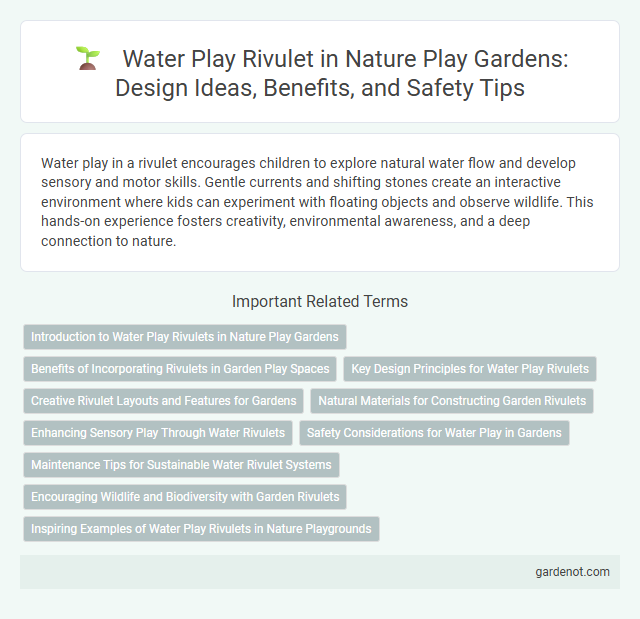Water play in a rivulet encourages children to explore natural water flow and develop sensory and motor skills. Gentle currents and shifting stones create an interactive environment where kids can experiment with floating objects and observe wildlife. This hands-on experience fosters creativity, environmental awareness, and a deep connection to nature.
Introduction to Water Play Rivulets in Nature Play Gardens
Water play rivulets in nature play gardens create dynamic, interactive channels that encourage exploration and sensory engagement for children. These shallow, flowing streams mimic natural waterways, fostering curiosity about water movement, cause and effect, and environmental processes. Integrating water play rivulets supports physical development, creativity, and eco-awareness in outdoor learning environments.
Benefits of Incorporating Rivulets in Garden Play Spaces
Rivulets in garden play spaces enhance sensory development by providing children with tactile and auditory stimulation through flowing water. Incorporating water play rivulets encourages exploration, creativity, and social interaction while fostering an understanding of natural water cycles and conservation. The dynamic movement of water also promotes fine motor skills and problem-solving as children manipulate flow paths and observe cause-and-effect relationships.
Key Design Principles for Water Play Rivulets
Water play rivulets should incorporate gentle slopes and natural materials like smooth stones and wood to mimic authentic stream environments and ensure safe, tactile exploration for children. Incorporating varied flow speeds and interactive elements such as dams and channels encourages problem-solving and sensory engagement. Designing with sustainability in mind, including water recirculation systems and native plant integration, enhances ecological benefits and promotes environmental stewardship.
Creative Rivulet Layouts and Features for Gardens
Creative rivulet layouts in gardens enhance water play by incorporating winding channels, varying depths, and natural materials like stones and pebbles to simulate authentic water flow. Features such as small waterfalls, gentle slopes, and interactive dams encourage exploration and sensory engagement, fostering imaginative play. Integrating native plants alongside the rivulet supports biodiversity and improves water filtration, contributing to a sustainable garden ecosystem.
Natural Materials for Constructing Garden Rivulets
Natural materials such as river stones, pebbles, and untreated wood provide durability and an authentic aesthetic for constructing garden rivulets. Incorporating organic elements like sand, mulch, and clay enhances water flow management while creating tactile sensory experiences in nature play areas. Using native plants alongside these materials supports local ecosystems and promotes sustainable water circulation within garden rivulets.
Enhancing Sensory Play Through Water Rivulets
Water rivulets in nature play environments create dynamic sensory experiences by engaging sight, touch, and sound. Flowing water stimulates tactile exploration while promoting cognitive development through observing movement and cause-and-effect relationships. Integrating water rivulets enhances outdoor play by encouraging creativity, fine motor skills, and environmental awareness in children.
Safety Considerations for Water Play in Gardens
Water play rivulets in gardens require careful safety measures to prevent accidents, such as ensuring water depth is shallow and flow gentle to reduce drowning risks. Installing non-slip surfaces and clear signage can help minimize slips and falls around wet areas. Regular maintenance to remove debris and monitor water quality protects children from potential infections and hazards.
Maintenance Tips for Sustainable Water Rivulet Systems
Regularly remove debris and sediment from the water channel to maintain clear flow and prevent blockages in the water rivulet. Inspect pumps, filters, and water circulation devices periodically to ensure efficient operation and reduce water waste. Implement natural filtration methods, such as planting aquatic vegetation, to enhance water quality and promote ecological balance in the play area.
Encouraging Wildlife and Biodiversity with Garden Rivulets
Garden rivulets create dynamic water play areas that attract diverse wildlife, fostering local biodiversity by providing essential habitats for insects, amphibians, and birds. These natural water channels support plant growth and encourage pollinators, enhancing ecosystem health and resilience. Integrating garden rivulets in nature play spaces promotes environmental stewardship and educates children on the importance of sustaining vibrant, living ecosystems.
Inspiring Examples of Water Play Rivulets in Nature Playgrounds
Water play rivulets in nature playgrounds create dynamic ecosystems where children engage with flowing water, enhancing sensory and motor skills. Examples like the Cascade Cove at Oregon Museum of Science and Industry and the Creekside Rivulet in Vancouver's Stanley Park showcase naturalistic designs that encourage exploration and environmental stewardship. These installations integrate natural materials and terrain to simulate authentic water movement, fostering imaginative play and ecological awareness.
Water play rivulet Infographic

 gardenot.com
gardenot.com